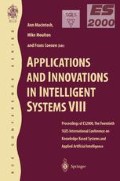Abstract
A microscopic simulation model representing traffic behaviour in the vicinity of merges, especially under congested situations, was developed. The simulation model was applied to produce a set of data representing traffic patterns in the merge area, ramp metering rates, and the corresponding vehicle journey times. The data were used to develop an artificial neural network (ANN) model, which anticipates the average journey time of mainline vehicles that enter an upstream section during a 30s interval. The ANN model was validated with an independent data set. An investigation was made to ensure that the ANN model and the simulation model are capable of demonstrating the onset of flow breakdown at high combinations of the mainline and the entry ramp traffic flow. The ANN model can be applied to develop an ANN based feedback control system, which adjusts ramp metering rates to keep the average journey times of vehicles close to their desired or target value, and to reduce congestion in the vicinity of merges.
Access this chapter
Tax calculation will be finalised at checkout
Purchases are for personal use only
Preview
Unable to display preview. Download preview PDF.
References
Papageorgiou, M., and Blosseville, J.M. (1989). Macroscopic mode1ing of traffic flow on the Boulevard Peripherique in Paris. Transportation Research B 23, 29–47.
Haj-Salem, H., Blosselville, J.M., and Papageorgiou, M. (1990). ALINEA-A local feedback control law for on-ramp metering: A real life study. 3rd International Conference on Road Traffic Control, London, 194–198.
Chin, S.M. (1992). Transportation demand forecasting with a computer simulated Neural Network model. Proc of Int. Conf. on Artf. Intel. Appl. in Transportation Engineering, San Buenaventura, CA, 349–390.
Dougherty, M.S., Kirby, H.R., and Boyle, R.D. (1993). The use of Neural Networks to recognize and predict traffic congestion. Traffic Engineering and Control 34(6), 311–314.
Chang, G.L., and Su, C.C., (1995). Predicting intersection queue with neural network models. Transportation Research C 13(3), 175–191.
Ledoux, C. (1996). An urban traffic control system integrating Neural Networks. IEE Conf. on Road Traffic Monitoring and Control, Conf. Publ. No. 422.
Zhang, H.M., and Ritchie, S.G. (1997). Freeway ramp metering using Artificial Neural Networks. Transportation Research C 5, 273–286.
NeuralWare Ltd. (1995). NeuralWorks Predict: Complete solution for neural data modeling. NeuralWare, Inc., Pittsburgh.
Fallah-Tafti, M. (1999). The application of simulation and Neural Networks to develop a ramp metering strategy, PhD Dissertation, The University ofWales, Cardiff, UK.
Hounsell, N.B., Bamard, S.R., and McDonald, M. (1992). An investigation of flow breakdown and merge capacity on motorways. Transport Research Laboratory, Berkshire.
Owens, D., and Schofield, M.J. (1988). Access control on the M6 motorway: Evaluation of Britain’s first ramp metering scheme. Traffic Engineering and Control 29(12), 616–623.
Taylor, C., and Meldrum, D. (1995). Simulation testing of a Fuzzy Neural Ramp metering algorithm. Washington State Department of Transportation, Olympia, Washington.
Author information
Authors and Affiliations
Editor information
Editors and Affiliations
Rights and permissions
Copyright information
© 2001 Springer-Verlag London
About this paper
Cite this paper
Fallah-Tafti, M. (2001). The Application of Artificial Neural Networks to Anticipate the Average Journey Time of Traffic in the Vicinity of Merges. In: Macintosh, A., Moulton, M., Coenen, F. (eds) Applications and Innovations in Intelligent Systems VIII. Springer, London. https://doi.org/10.1007/978-1-4471-0275-5_12
Download citation
DOI: https://doi.org/10.1007/978-1-4471-0275-5_12
Publisher Name: Springer, London
Print ISBN: 978-1-85233-402-4
Online ISBN: 978-1-4471-0275-5
eBook Packages: Springer Book Archive

